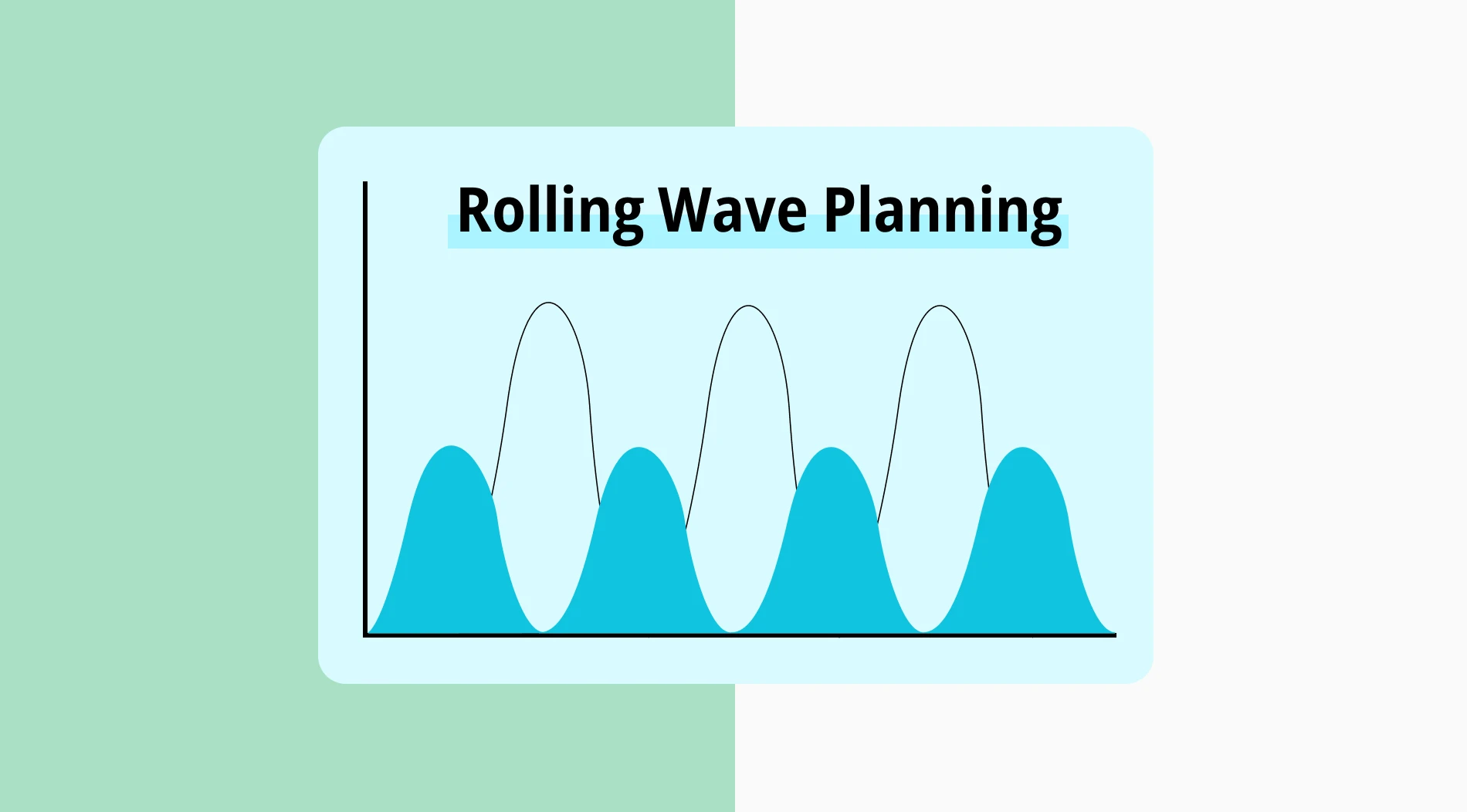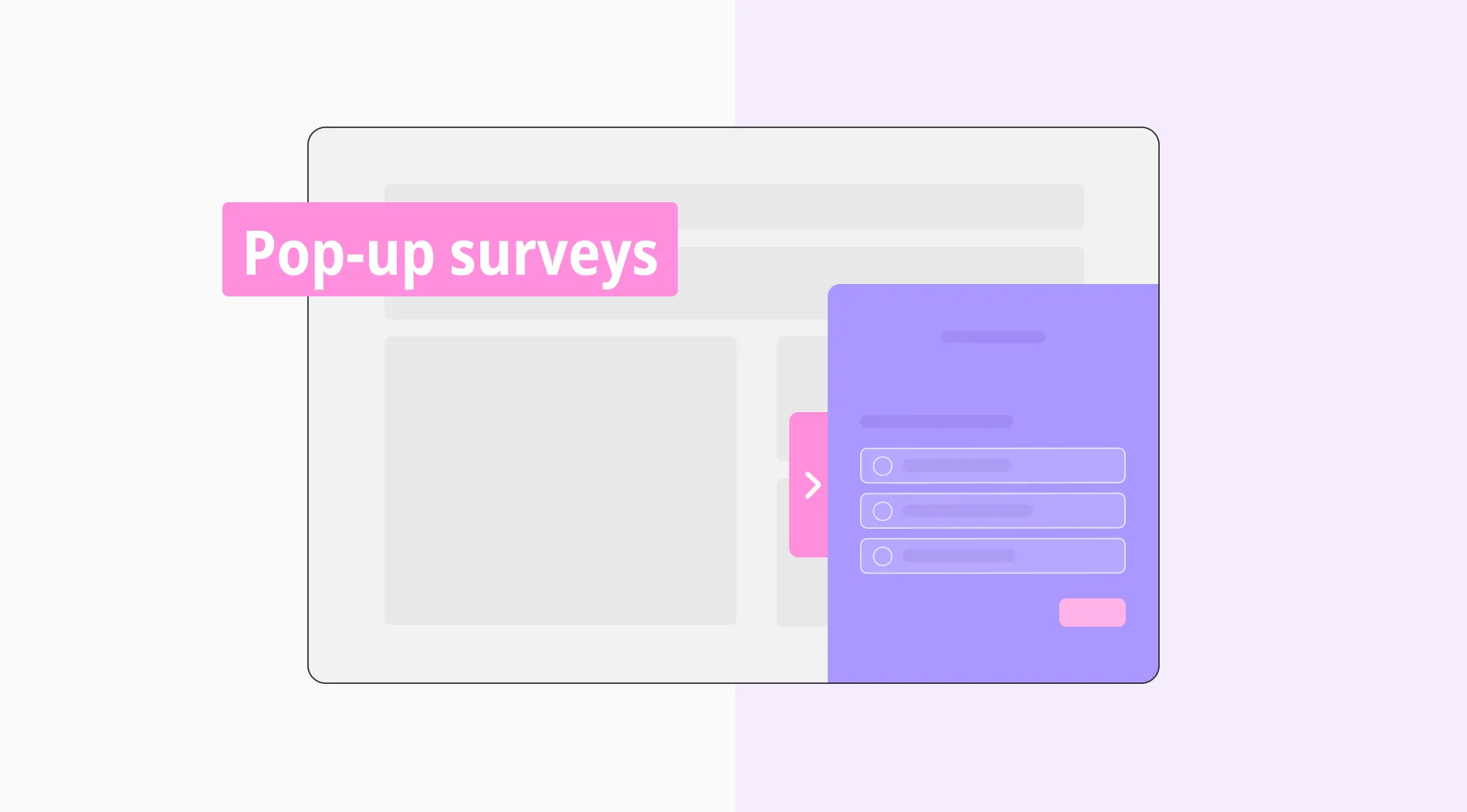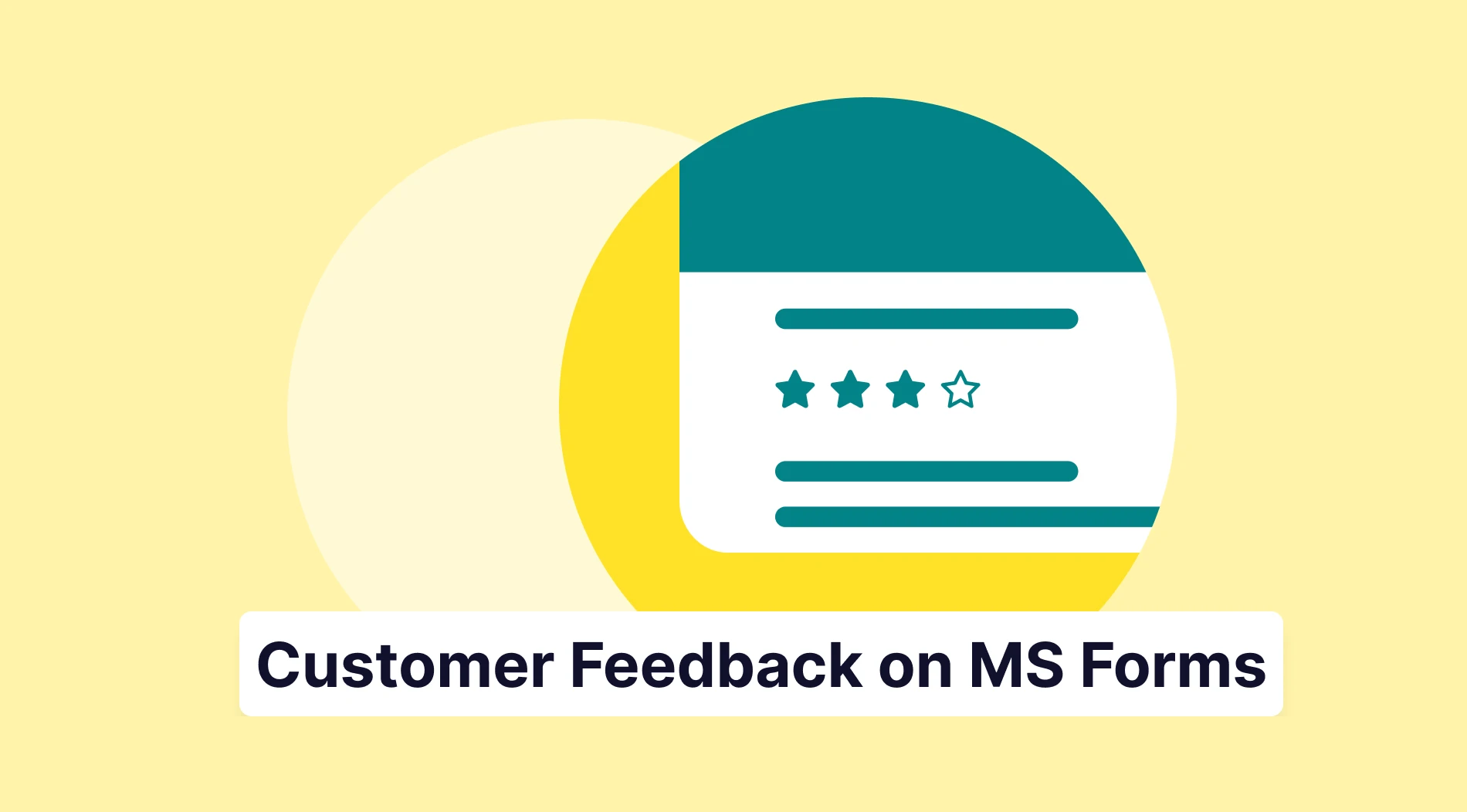In today’s fast-paced business world, your business needs tools to stay agile and adapt to changes quickly. There are many methods allowing for planning in phases, making it easier to adjust to new information and circumstances. By using these tools, you can manage complex projects more effectively and ensure that your business stays on track and within budget.
Today, we will talk about one of these tools, the Rolling Wave Planning(RWP), in detail. We’ll start by defining what RWP is and explaining its core principles. Then, we’ll discuss when and how to use this approach. We’ll also look at some of its advantages and disadvantages. Finally, we’ll answer some frequently asked questions to help you better understand the subject.
What is Rolling Wave Planning?
Rolling Wave Planning is a project management technique that involves planning projects in phases or “waves.”
Instead of creating a detailed plan for the entire project, you can develop plans for the near term and leave future details more flexible. This approach allows for adjustments as your project progresses and more information becomes available. It is particularly useful in complex projects where not all details are known from the start.
In Rolling Wave Planning, you divide the project into distinct phases, focusing on detailed planning for the current phase while keeping later phases less defined. As the project progresses, you revisit and refine the plan for the next phase based on new insights. This continuous planning and reassessment allow the team to adapt to changing circumstances, ensuring plans remain relevant and responsive.
Steps for Rolling Wave Planning
Now that we are familiar with the concept of “Rolling Wave Planning,” let’s dive into how to use this method. We will discuss 6 Rolling Wave Planning steps to effectively implement the rolling wave planning in your projects. Understanding these steps will help you carry out your projects in a smooth way:
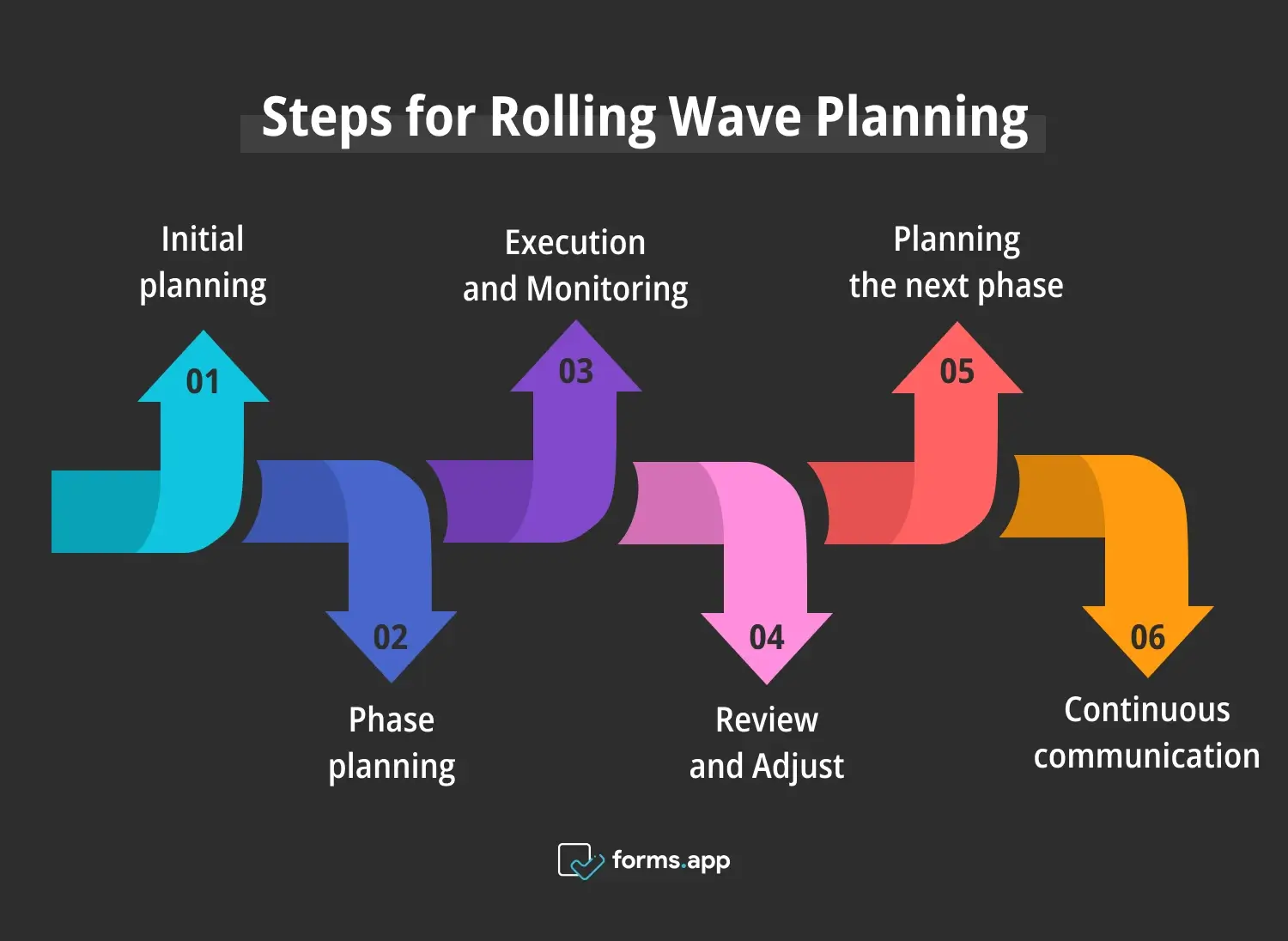
Rolling Wave Planning steps
Step 1: Initial planning
Begin with a high-level plan that outlines the project’s goals, key deliverables and major milestones. This plan needs to provide a broad overview of the entire project and establish the overall framework. It includes the project’s scope, timeline and resource requirements. The initial plan should be wide enough to give direction.
However, it should also be flexible to allow for adjustments as more information becomes available. This stage involves setting clear objectives and identifying the critical path of the project. It’s crucial to involve all key stakeholders in this phase. This ensures that your team members can agree on the project’s goals and expectations.
Step 2: Phase planning
For your current phase, develop a detailed plan including specific tasks, deadlines and responsibilities. Your phase plan should be actionable and clear and ensure that your team knows what they are doing. Break down the phase(s) into smaller, manageable tasks and assign them to team members.
Make sure to include timelines, milestones, and resource allocation in this detailed plan. Regularly review and update the phase plan to reflect any new information or changes. This approach ensures that your team remains focused on the immediate goals while you can keep an eye on the overall project objectives.
Step 3: Execution and Monitoring
Execute the detailed plan for the current phase while continuously monitoring progress. Track performance against the plan and identify any deviations. Take corrective actions as needed. Use the project management software/tools to monitor key metrics such as time, cost, and quality. Regular status meetings can help identify issues early.
This can also ensure that the project stays on track. Effective communication is very important during this stage. It ensures that all team members are aware of their tasks and any changes in the plan. This continuous monitoring helps maintain control over the project and ensure timely task completion.
Step 4: Review and Adjust
Conduct a thorough review at the end of each phase to evaluate performance and gather insights. You need to assess what worked well and what did not. You can use this information to adjust the plans for the next phase. Hold a meeting with the team to discuss successes, challenges, and areas for improvement.
Document tense findings and include them in the planning process for the next phase. This dynamic process of review and adjustment helps in refining the project plan based on real-world experience and feedback. It ensures that the project remains on course and meets its objectives.
Step 5: Planning the next phase
Using the insights from the review, develop a detailed plan for the next phase. This plan should incorporate any changes or adjustments based on the lessons learned from the previous work. You should define the upcoming phase's tasks, deadlines, and responsibilities. Ensure that the plan is realistic and achievable.
Take into account the resources available and any potential constraints. This step involves forward planning while keeping the flexibility to adapt to new information. It ensures that the project progresses smoothly from one phase to the next. This will maintain momentum and continuity.
Step 6: Continuous communication
Maintain open and continuous communication with all stakeholders throughout the project. Regularly update them on progress, changes, and any new developments. Hold frequent meetings and use project management (Rolling Wave Planning) tools to keep everyone informed. Effective communication will ensure that your team members and stakeholders stay on the same page.
It will also enable them to be aware of their roles and responsibilities. It helps manage expectations and address any concerns promptly. This step fosters a collaborative and transparent project environment and reduces the risk of misunderstandings. It will ultimately ensure that your project stays on track and meets its objectives.
When to use Rolling Wave Planning
We have covered six steps of the Rolling Wave Planning. This method is applicable to various types of projects. Let’s cover the suitable environments in which you can use it. Understanding these contexts will enable you to implement RWP effectively in your projects:
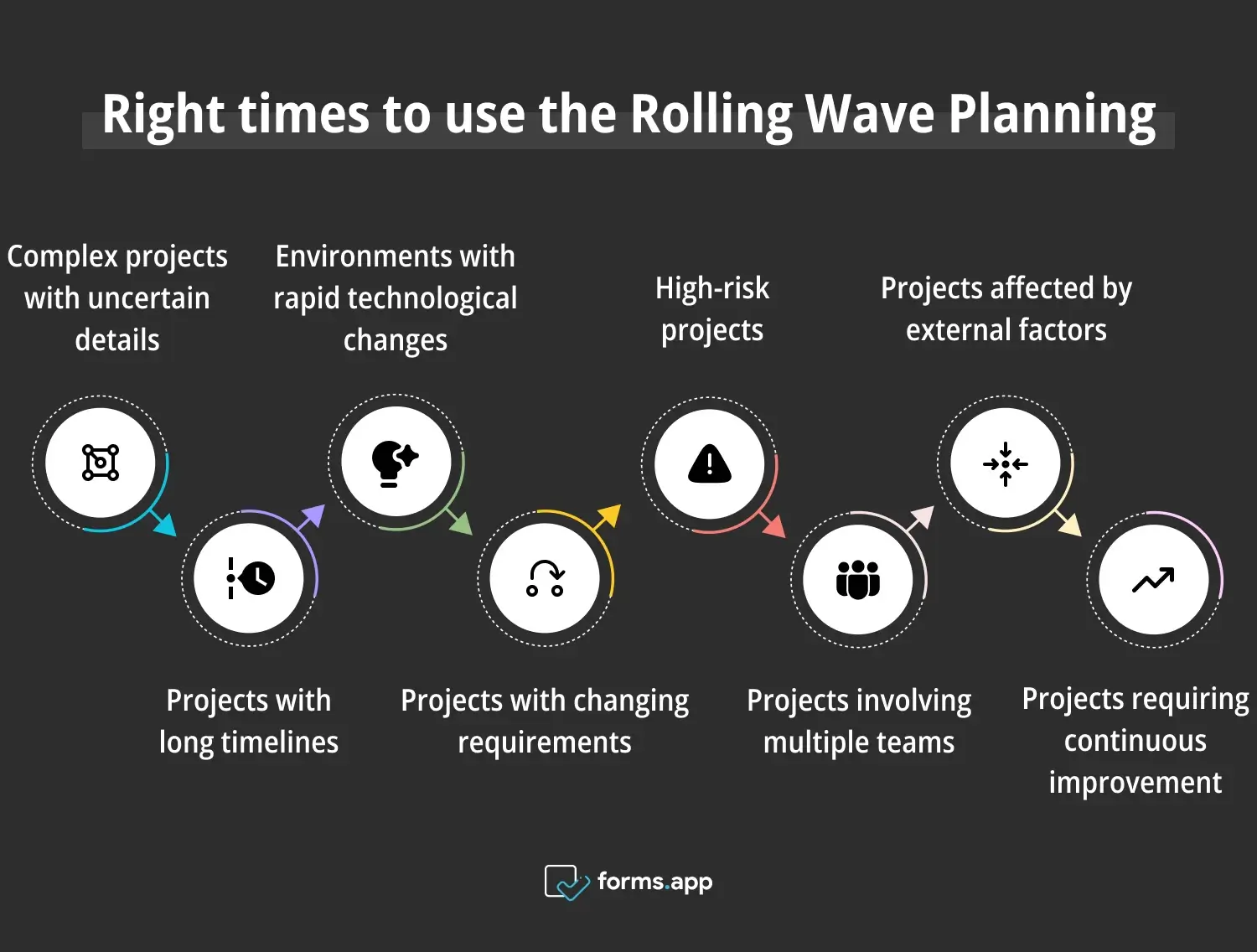
Correct times to use the Rolling Wave Planning
1. Complex projects with uncertain details
Rolling Wave Planning is ideal for complex projects with many unknowns. When the details of your project aren’t clear at the start, planning in waves will allow your team to adjust as they learn more. This method is beneficial for projects like new product development or large construction efforts where not all information is available.
2. Projects with long timelines
For projects that spread over long periods, Rolling Wave Planning offers a way to manage the extensive timeline without your team becoming overwhelmed. Instead of detailing every aspect of the project from the start, your team can create a high-level plan and then develop detailed plans for shorter, more manageable phases. This approach ensures project adaptability to changes.
3. Environments with rapid technological changes
In industries where technology evolves quickly, Rolling Wave Planning helps teams stay current. If your projects involve advanced technologies, you can benefit from this approach. Because it allows for flexibility and adjustments as you progress. By planning in waves, your team can include the latest innovations in their project. They can ensure the final product is up-to-date.
4. Projects with changing requirements
Rolling Wave planning is particularly useful when stakeholder requirements are likely to change throughout the project. This method allows your team to adjust plans based on new feedback and evolving needs. It ensures that the project remains aligned with stakeholder expectations. Regular reviews and updates keep stakeholders informed and involved. This leads to higher satisfaction.
5. High-risk projects
For projects with high-risk levels, Rolling Wave Planning provides a way to manage and mitigate these risks effectively. If you break the project into smaller phases, your team can identify the potential issues early and address them. This proactive approach helps you maintain control over the project. It also ensures that your team stays on track and within budget.
6. Projects involving multiple teams
Rolling Wave Planning is very effective for projects requiring collaboration across multiple teams or departments. This approach helps you coordinate efforts and ensures that all teams are on the same page about the overall project goals. If you make your plans in waves, your teams can synchronize their work and reduce the risk of miscommunication. This ensures successful phase completion.
7. Projects affected by external factors
Sometimes, the external factors such as regulatory changes, market shifts or technological advancements can impact your project. Here, Rolling Wave Planning offers the flexibility needed to adapt. Your teams can adjust their plans based on these external influences. This ensures that your project remains relevant and compliant. This adaptability helps you navigate uncertainties and maintain project momentum.
8. Projects requiring continuous improvement
Rolling Wave Planning is very suitable for projects requiring continuous improvement and development. In such projects, your team can implement feedback and make improvements in each phase. This approach is common in agile software development, where frequent updates are necessary. If you plan in waves, you can ensure a high-quality final product.
How can you use rolling wave planning for project management?
We have seen the suitable contexts and projects in which you can use Rolling Wave Planning. Here, we will give you some tips on how to use Rolling Wave Planning effectively in project management. Implement these steps and realize the difference:
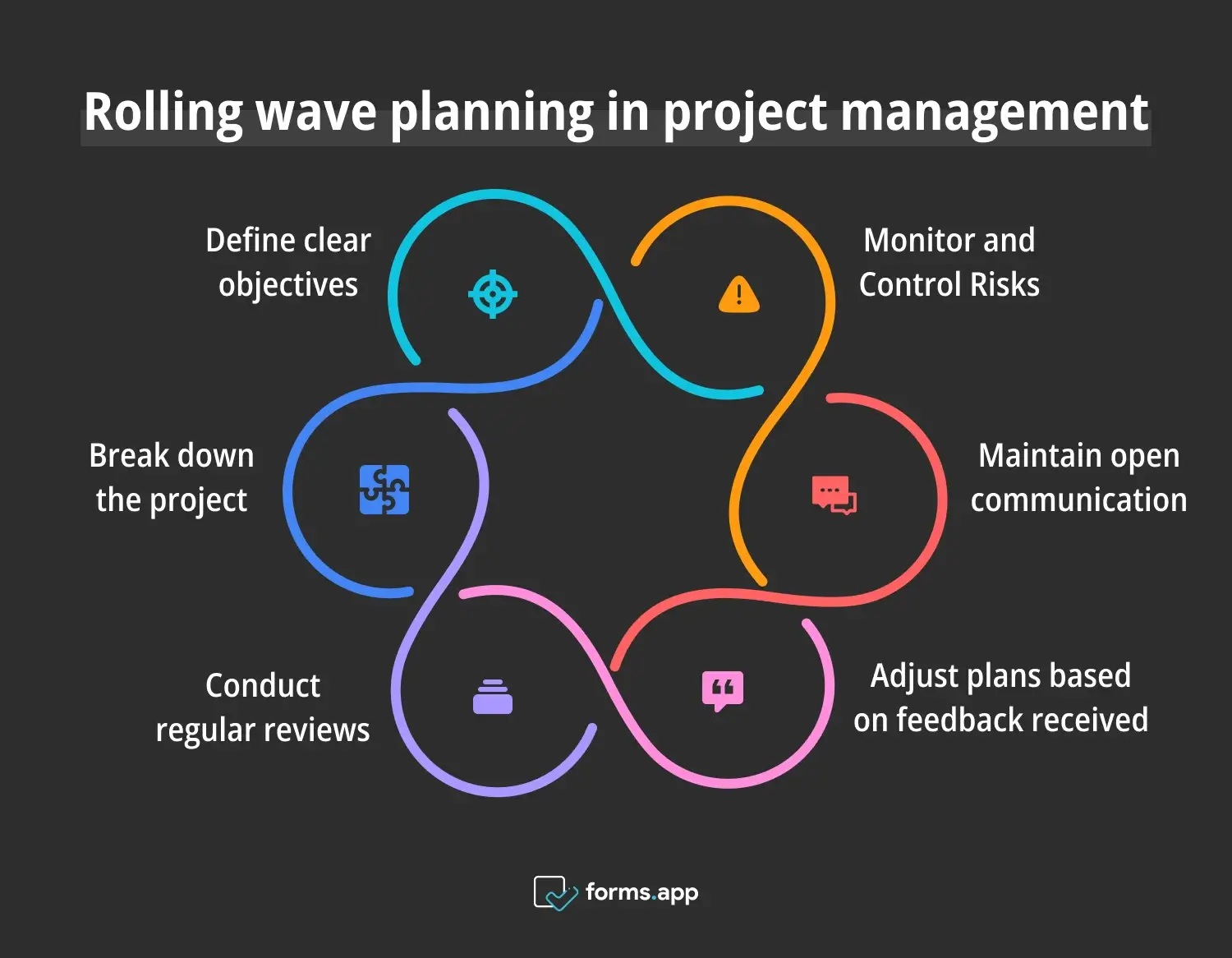
How to use rolling wave planning for project management
1- Define clear objectives
Start by defining clear, specific objectives for your project. Establishing well-defined goals helps you create a high-level plan that will outline major milestones and deliverables. Clear objectives ensure that your team members understand the project’s end goals and can align their efforts accordingly.
Detailed objectives also help in setting priorities and making informed decisions throughout the project. Communicate these objectives effectively to all stakeholders to gain their support and commitment. Clear objectives act as a roadmap, guiding the project through its phases and ensuring that all efforts contribute towards achieving the desired outcomes.
2- Break down the project
Divide the project into phases or waves, each with its own set of tasks, deadlines, and responsibilities. This work breakdown structure makes it easier to focus on one phase at a time reduces complexity, and improves manageability. Each phase should have clear objectives and deliverables that align with the overall project goals.
If you address one phase before moving to the next, you can better manage resources and track progress. You can also make adjustments as needed. This approach allows for a more detailed and actionable plan for work packages. It enhances overall project control and efficiency.
3- Conduct regular reviews
At the end of each phase, conduct thorough reviews to assess performance and gather insights. Evaluate the progress made against the planned objectives and identify any discrepancies or issues. Use these reviews to gather feedback from the team and stakeholders, which provides valuable insights for refining the plans for the next phase.
This iterative review process helps in identifying potential problems early and allows for timely corrective actions. Regular reviews ensure that the project remains aligned with its goals, adapts to any changes, and addresses any challenges effectively.
4- Adjust plans based on feedback received
Incorporate feedback gathered during the phase reviews to adjust the plans for subsequent phases. Evaluate the feedback to determine what changes or new requirements need to be integrated into the project plan. This iterative adjustment process helps in keeping the project plan relevant and responsive to evolving needs and circumstances.
By being flexible and adaptable, you can manage uncertainties more effectively and ensure that the project remains on track. Adjustments based on feedback also help align the project with stakeholder expectations and improve overall project outcomes.
5- Maintain open communication
Ensure open and continuous communication with all stakeholders throughout the project. Provide regular updates on progress, changes, and any new developments to keep everyone informed and engaged. Effective communication fosters collaboration and helps in addressing any concerns or issues promptly.
It also reduces the risk of misunderstandings and ensures that all team members are aligned with the project goals and objectives. By maintaining transparency and encouraging feedback, you can create a collaborative environment that supports successful project execution and stakeholder satisfaction.
6- Monitor and Control Risks
Continuously monitor and control risks throughout the project lifecycle. Identify potential issues early through regular risk assessments and take proactive measures to address them before they escalate. Implement risk management strategies and contingency plans to mitigate the impact of identified risks.
This proactive approach helps in maintaining control over the project and ensures that it stays on track and within budget. Effective risk management also contributes to overall project success by minimizing disruptions and ensuring that project objectives are achieved despite unforeseen challenges.
Examples of the Rolling Wave Planning
Here, let’s take a look at some Rolling Wave Planning examples. We will examine how some of the most famous institutions and corporations used the RWP and got positive results. Reading these examples will enable you to better understand the Rolling Wave Planning technique:
1- NASA - Mars Rover Project
NASA used Rolling Wave Planning for its Mars Rover project. The team started with a high-level plan outlining the mission's objectives and major milestones. As the project progressed, they developed detailed plans for each phase based on new data and insights. This iterative approach allowed them to adapt to the challenges of space exploration.
2- Boeing 787 - Dreamliner
Boeing employed Rolling Wave Planning for the development of the 787 Dreamliner. The project involved complex engineering and integration of new technologies. By planning in waves, Boeing was able to incorporate new information and adjust their approach as needed. This flexibility helped them manage the complexities and deliver the aircraft successfully.
3- Apple - iPhone Development
Apple used Rolling Wave Planning for the development of the iPhone. The project involved multiple teams working on different aspects of the device. By breaking the project into phases and planning in detail for each phase, Apple was able to ensure that all teams were aligned and that the project progressed smoothly. This approach contributed to the successful launch of the iPhone.
Advantages & Disadvantages of the Rolling Wave Planning
We now have a good understanding of the concept, suitable environments, and examples of the Rolling Wave Planning methods. As briefly mentioned at each point, there are a lot of advantages to using RWP in your projects. However, you should also take into account some issues and be careful. Let’s take a look at some benefits of Rolling Wave Planning as well as some drawbacks:
Advantages
➕Flexibility: Rolling Wave Planning allows for flexibility in project management. Teams can adjust their plans as new information becomes available, ensuring that the project stays relevant and responsive to changes. This adaptability is crucial in dynamic environments where project requirements can evolve.
➕Better risk management: This approach helps identify and manage risks early. By planning in shorter waves, teams can detect potential issues before they escalate. This proactive risk management leads to better outcomes and reduces the likelihood of project failures.
➕Improved stakeholder communication: Rolling Wave Planning fosters continuous communication with stakeholders. Regular updates and reviews ensure that stakeholders are informed about the project's progress and any changes. This transparency helps build trust and maintain stakeholder satisfaction.
➕Enhanced team focus: By breaking the project into manageable phases, Rolling Wave Planning helps teams focus on one phase at a time. This focused approach reduces the complexity and allows teams to concentrate their efforts on achieving specific milestones, leading to better performance.
➕Efficient resource use: Rolling Wave Planning allows for efficient allocation and use of resources. By planning in detail for the immediate future, teams can ensure that they have the necessary resources available when needed. This reduces waste and ensures that resources are used effectively.
➕Increased project control: This approach provides better control over the project. Regular reviews and adjustments help in keeping the project on track. Project managers can make informed decisions based on real-time data, ensuring that the project progresses as planned and achieves its objectives.
Disadvantages
➖Requires continuous monitoring: Rolling Wave Planning requires continuous monitoring and adjustment. This can be time-consuming and may require additional resources. Teams need to be vigilant and proactive in managing the project, which can increase the workload.
➖Potential for scope creep: The flexibility of Rolling Wave Planning can sometimes lead to scope creep. As the project evolves, new requirements may emerge, leading to changes in the project scope. This can increase the project's complexity and duration if not managed carefully.
➖Dependence on accurate information: The success of Rolling Wave Planning depends on having accurate and timely information. If the data used for planning is incomplete or incorrect, it can lead to poor decisions and project delays. Teams need to ensure that they have reliable information for effective planning.
Frequently asked questions about Rolling Wave Planning
Finally, let’s find answers to some of the most frequently asked questions about Rolling Wave Planning. Understanding the answers to these questions will give you a clearer view of the implementation and nuances of the RWP:
Rolling Wave Planning involves planning in phases, with detailed plans for the near-term goals and flexible plans for the future. Sprint Planning, a component of Agile methodology, involves planning short, time-boxed iterations called sprints, usually lasting 1-4 weeks. Sprint Planning focuses on completing specific tasks within each sprint, whereas Rolling Wave Planning focuses on continuous reassessment and adjustment of the overall project plan.
Rolling Wave Planning and Progressive Planning, both involve iterative planning processes. However, Rolling Wave Planning focuses on detailed planning for the immediate phase while keeping future phases flexible. Progressive Planning involves gradually adding detail to the overall project plan as more information becomes available. The main difference lies in the focus: Rolling Wave Planning prioritizes the current phase, while Progressive Planning continuously refines the entire project plan.
Rolling Wave Planning and Agile Sprints both aim to improve flexibility and adaptability in project management. Rolling Wave Planning involves planning in waves, with detailed plans for the current phase and flexible plans for future phases. Agile Sprints involve planning short, time-boxed iterations with specific tasks to complete within each sprint. Agile Sprints emphasize rapid delivery and frequent feedback, while Rolling Wave Planning focuses on continuous reassessment and adjustment of the project plan.
Conclusion
In conclusion, Rolling Wave Planning is a flexible and adaptive project management approach that helps teams manage complex projects. By planning in phases and continuously reassessing and adjusting the plan, teams can stay responsive to changes and manage risks effectively. This method fosters better communication with stakeholders and enhances team focus.
In this article, we have covered the essentials of Rolling Wave Planning, its suitable environments, and how to use it in project management. We have also looked at advantages/disadvantages and examples from famous companies. Last but not least, we have answered some of the most frequently asked questions about the subject. Now, you can implement it in your projects!
Fatih is a content writer at forms.app and a translator specializing in many text domains, including medical, legal, and technical. He loves studying foreign languages. Fatih especially likes to create content about program management, organizational models, and planning tools.
- What is Rolling Wave Planning?
- Steps for Rolling Wave Planning
- When to use Rolling Wave Planning
- How can you use rolling wave planning for project management?
- Examples of the Rolling Wave Planning
- Advantages & Disadvantages of the Rolling Wave Planning
- Frequently asked questions about Rolling Wave Planning
- Conclusion
